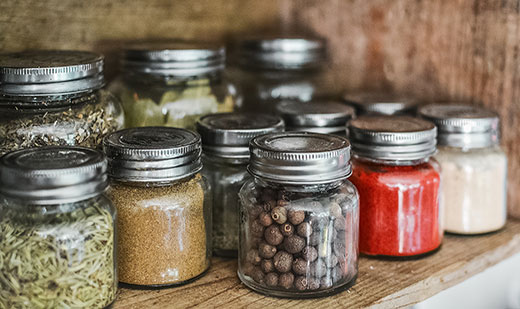
Learn to use what's currently available on kitchen shelves to make creative meals.
Cupboards going bare? Tasty meals can be one creative idea away
K-State specialist publishes guide for using many foods in familiar dishes
July 12, 2020
MANHATTAN, Kan. – Tandy Rundus believes creativity finds a place in the kitchen when the cupboards are bare.
A specialist for the Supplemental Nutrition Assistance Program Education (SNAP-Ed) in northeast Kansas, Rundus has outlined many creative solutions for using what’s in stock and stretching the family’s food budget in a publication now available from K-State Research and Extension.
Cooking Basics: Make a Meal from What’s on Hand is available for free online, guiding home chefs through creative ways to use the foods they have on hand to make many of their favorite dishes.
“That concept transcends socio-economic status,” Rundus said. “Some people may have stocked up on food during the pandemic and now have several items that they need to use up. Others are in a situation where their income is tighter and using up every food item on hand helps to stretch the food dollar.”
Rundus said when supplies are low in the pantry, common recipes can be used as “road maps” for making meals. “Just as there are alternate roads on a map to arrive at a specific destination, there are alternate options to complete that recipe,” she said.
The publication promotes the concept of grouping ingredients into categories:
- Proteins, including various meats, eggs, fish, seafood, nuts and legume-type beans.
- Vegetables, fresh, frozen or canned.
- Starch, including pasta, rice and potatoes.
- Liquid, including broths, tomato juice and milk.
- Sauce, including various soups, diced tomatoes with juice and gravy made with corn starch and water.
- Flavors, which could be combinations of chopped vegetables, dried or fresh herbs, worcestershire sauce, soy sauce and salt and pepper.
With those groupings in place, Rundus said it’s much easier to combine ingredients to make stir fry, skillet meals, casseroles, soups, salad, pizza and more.
“Too often, we find that certain items are not stocked as regularly in stores, or depending on the time of day I shop, the exact item I need is out,” Rundus said. “By thinking outside the box with my recipe just as a guide, I can still create a healthy meal for my family with what I have at home in the pantry, garden, commodity food box or from the shelf of a store or food pantry.”
Rundus said Kansas extension agents who have SNAP-Ed grants will be applying the concept of creating meals from what’s on-hand in upcoming classes, which are based on curriculum originally developed in Utah.
The publication is the latest in a series from a team of K-State Research and Extension professionals who focus on nutrition, food safety and health, highlighting Kansans’ interest in improving their basic cooking skills during the current pandemic. Rundus said that from April 2-20, K-State Research and Extension surveyed 1,341 state residents and found that meal planning and preparation were among the concerns of several respondents.
Since that time, Rundus and colleague Lisa Martin, a Shawnee County agent working with SNAP-Ed and the Expanded Food, Nutrition and Education Program, have published the following fact sheets:
- The Well-Stocked Kitchen: Pantry and Nonrefrigerated Foods
- The Well-Stocked Kitchen: Refrigerated and Frozen Foods
- Cooking Basics: Measuring Tools and How to Use Them
- Cooking Basics: Cooking Terms
K-State nutrition specialist Sandy Procter emphasized the value of cooking as a family.
“Learning to create meals -- or snacks for that matter -- from what is on hand is a skill that will serve kids and adults well, and builds resilience,” she said. “If a teen is able to look in the refrigerator or cupboard and visualize a meal from what is on hand, there is a better chance they will be able to feed themselves, and others, regardless of circumstances. Parents can help children develop this ability at an early age by talking about building recipes, substituting ingredients when needed and instilling confidence.”
Procter and many colleagues developed a publications series titled Essential Living Skills, which also is available through the K-State Research and Extension bookstore. She said many of the university’s publications help kids and parents review basic concepts and build life skills.
“Kids with those skills are well-equipped to help out at home and also care for themselves as they grow up,” she said. “Cooking skills allow people to save money and eat more healthfully than if they ate more meals away from home. During the recent stay-at-home times, people clearly recognized the benefits of cooking at home and getting creative with meal prep using ingredients they had on hand.”

